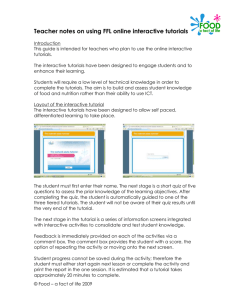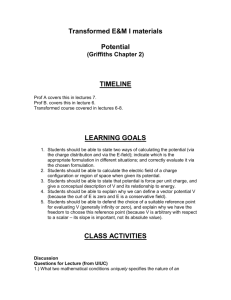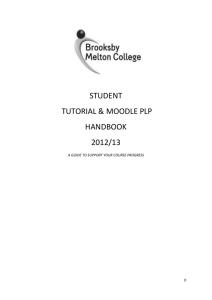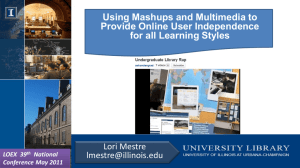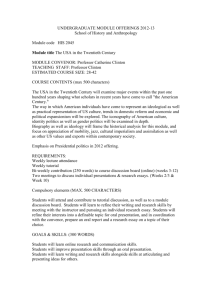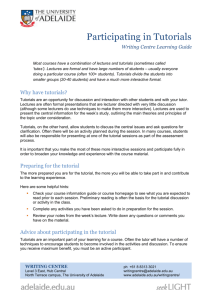PROJECT SCOPE
advertisement
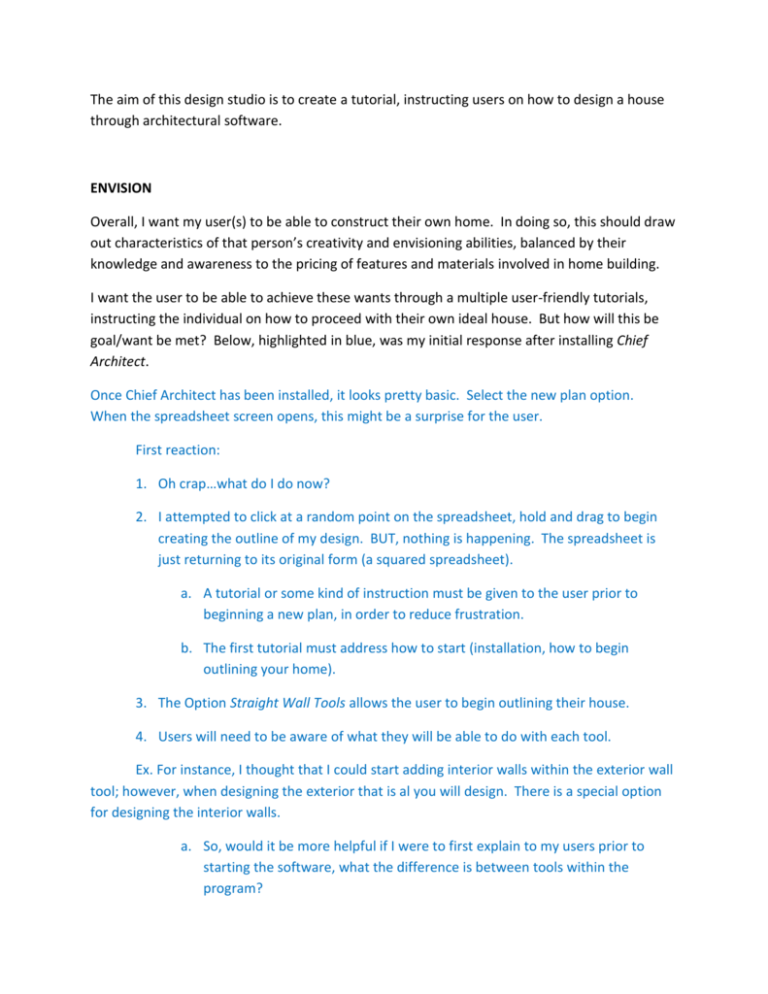
The aim of this design studio is to create a tutorial, instructing users on how to design a house through architectural software. ENVISION Overall, I want my user(s) to be able to construct their own home. In doing so, this should draw out characteristics of that person’s creativity and envisioning abilities, balanced by their knowledge and awareness to the pricing of features and materials involved in home building. I want the user to be able to achieve these wants through a multiple user-friendly tutorials, instructing the individual on how to proceed with their own ideal house. But how will this be goal/want be met? Below, highlighted in blue, was my initial response after installing Chief Architect. Once Chief Architect has been installed, it looks pretty basic. Select the new plan option. When the spreadsheet screen opens, this might be a surprise for the user. First reaction: 1. Oh crap…what do I do now? 2. I attempted to click at a random point on the spreadsheet, hold and drag to begin creating the outline of my design. BUT, nothing is happening. The spreadsheet is just returning to its original form (a squared spreadsheet). a. A tutorial or some kind of instruction must be given to the user prior to beginning a new plan, in order to reduce frustration. b. The first tutorial must address how to start (installation, how to begin outlining your home). 3. The Option Straight Wall Tools allows the user to begin outlining their house. 4. Users will need to be aware of what they will be able to do with each tool. Ex. For instance, I thought that I could start adding interior walls within the exterior wall tool; however, when designing the exterior that is al you will design. There is a special option for designing the interior walls. a. So, would it be more helpful if I were to first explain to my users prior to starting the software, what the difference is between tools within the program? b. Should I just make a cheat sheet, giving a brief description of each tool and its function? c. Do I instruct the users to read the word document first? Or do I just inform them which tools to use as they progress within the tutorial? 5. Users will need to be informed that they will not be able to adjust the exterior walls while making the outline of the house; however, they can delete and re-draw. Once they begin working on their interior walls though, they will be able to adjust the exterior walls. 6. Would it be a good idea to zoom in on certain tools, allowing the user to get a better look at the item being selected? This can apply to other things as well. So, as you can see, certain questions must be asked and resolved before the design or structure of a tutorial can begin. Not to mention, I need to attempt to accommodate my user. Therefore, I need to ask myself the following questions 1. Exactly who is my target audience? 2. Does my audience know anything about home building materials? 3. Is this tutorial applicable to ALL users (is this applicable to all ages)? With that much being said, I will enter this assignment with the impression that my users are 1), my audience are individuals capable of seeing, learning, and applying what they have watched (from the tutorials) into motion. It is also assumed that the user is enrolled within higher education-based courses, above the age of 25. 2) I will enter this project assuming that my users are unfamiliar with building materials; and 3) I will inform users that this might be more difficult for users with a vision impairment or problems with fine-motor skills (being able to move a mouse); however, navigation within this program is still possible, yet more difficult. DESIGN Being more aware of what I need to take into consideration before designing my tutorials, my next phase is determining what points I will discuss /present in each video. I want the design to be structured in a format that is simple, and allows the learner to follow the video, enabling the user to begin constructing their home design, after watching the video. Learner should be able to manipulate the feature being discussed within the tutorial, with only having to watch the video once. Designing each tutorial, I will be referring to a cheat sheet (highlighting what points I need to mention, such as “what objectives the video will be addressing,” stating what steps will be taken in order to construct the feature prior to starting, as well as recapping the steps that occurred throughout the video towards the end of the video. Once my videos are finished, I will then edit the videos, adding a list(s) within the video. These lists will present the objectives of the video, the steps going to be covered, and the recapping of the steps learned. These lists/captions will be inserted in their designated segment. *** Before the recap of the steps is shown though, the learners will be asked “do you remember the steps needed to complete this task?” Therefore, in order to interact with the learner, I will ask the learners to “take 10 seconds to recall the steps you just went through.” Then, I will recap over the steps, showing the list of the steps previously discussed. Lastly, the learner will be asked “so how well did you remember the steps mentioned in the video? Do you think you’re ready to go and construct your _____ now?” *** After completing a tutorial, I will be asking for feedback from family members, friends, and my roommates. The grounds on which they will be evaluating my videos will be based on articulation, clarity, organization, and presentation. I will be using a rapid prototyping approach throughout this project. For this project, this is probably the best fit. The reason being, I am not the best speaker; therefore, receiving feedback and guidance on how I might improve my videos can and will be crucial for the success of the user. I want the user to understand what is being taught. Containing multiple videos, each discussing an important feature within Chief Architect, averaging around 3 minutes per video, a webpage will need to be created to organize the sequence of the videos (start to end). In order for the learner to get the most out of the tutorials, each video will contain a caption entailing what objectives will be reached from the video, as well as an overview/recap of the steps that will be undergone before and after the video. Through the organization of the webpage, I want the user to have the impression that the tutorials can and will help them in each step of building their house. All in all though, the delivery and organization of my instruction is the key to my project’s success. Despite the media used to produce the tutorials, the media cannot instruct the user on what to do and where to go next. This is one of those instances where a person would side with Clark and say “without good instruction, media is useless.” Not necessarily “useless” in the context of ineffective, but useless in the sense of the media becoming exponentially more difficult, leading to feelings of frustration. Good instruction can reduce these problems; and furthermore, become the foundation of future mediums. If well-written, organized, and logical, good instruction is long lasting, unlike most mediums which can be replaced by another medium within a year or so? Within this project, I will be using multiple mediums, such as: 1. 2. 3. 4. Chief Architect BB Flashback Express (Screen recorder) Windows Live Movie Maker (Editing the recording) Audacity (Audio editor) The usage of these mediums will go as follows. BB Flashback Express will be the first medium to be utilized. Once the recording has commenced, then Chief Architect can be utilized. Upon completion of the recording, the recording will then be opened within Windows Live Movie Maker. Within Movie Maker, lists will be added to the recording. Audacity will then be used to transport background music to the video. The background music should aid in filling silence.

